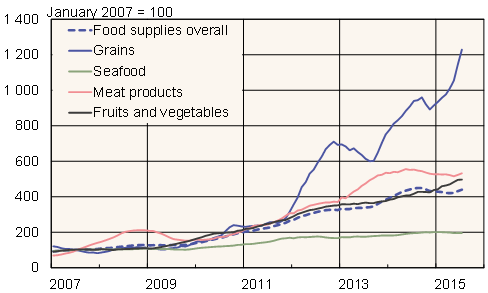BOFIT Weekly Review 37/2015
Chinese food imports up
Growth in domestic food production has failed to keep up with growing consumer demand and shifting consumer habits, even if China seeks to achieve self-sufficiency in many basic agricultural products. Agriculture now accounts for about 9 % of GDP, down from 15 % at the start of the 2000s. In the meantime, food imports have risen 18 % a year on average.
Despite low productivity, China remains the world’s largest agricultural producer. Chinese farms are typically quite small and poorly suited to modern mechanised farming techniques. Further, the total area of available farmland continues to decline as a result of increasing environmental degradation and the loss of natural services. Agriculture has been hurt particularly by the lack of clean irrigation water and soil pollution. An official report released in 2014 found that nearly 20 % of China’s farmland is toxified due to pollution and excessive use of fertilisers and pesticides.
Urbanisation reduces the rural labour force and the amount of available farmland, but it also increases average consumer incomes and reshapes consumption habits. China’s environmental problems and scandals in the food industry have increased demand for foreign products, which are seen as safer than the local option in many cases. Strong growth has been seen in imports of grains, meat, vegetables and fruits.
Data compiled by China Global Investment Tracker show how China has invested $43 billion over the past ten years in agricultural projects around the world. Chinese firms have partnered with foreign agricultural producers in order to learn how to enhance their productivity with the latest production methods and to import foreign produce to China. China has also entered into bilateral trade agreements with numerous countries to ease food imports.
Value of Chinese food imports and of various food supplies

Source: Macrobond